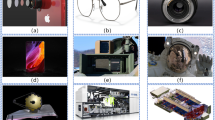Abstract
This paper presents an elliptical vibration machining (EVM) method, which is utilized to establish a micro-dimple or groove pattern for surface texturing. The EVM has been explored extensively by the precision community to significantly improve machining performance through lower cutting force, reducing tool wear, burr suppression, extended tool life and lower surface roughness. A new design of a tool holder has been developed, yielding two-directional motions of the tool tip of about 10 μm and 30 μm in the axial and transverse directions, respectively. The tool holder design uses a four-bar flexure hinge, of which the flexure body has a first natural frequency of about 4.6 kHz according to an impact test. In this research, two piezo actuators have been driven in open-loop conditions by energizing two sinusoidal voltages from a function generator with the developed tool holder attached to a conventional computer numerical controlled (CNC) 3-axis milling machine. The micro-dimples and grooves have been successfully built using a vibration frequency of 100 Hz with various phases between 15o and 60o to verify the cutting performance of the developed tool holder.
Similar content being viewed by others
Abbreviations
- K R :
-
Overall stiffness of the flexure body
- K B :
-
Bending stiffness of single circular flexure hinge
- K S :
-
Linear stiffness of single circular flexure hinge
- F :
-
Generated force from piezo actuator
- x, z :
-
Cartesian coordinate axis
- D 1 , D 2 :
-
Output displacement of 1st and 2nd piezo actuators
- L 1 , L 2 :
-
Length of the center rotation perpendicular to force direction in the z and x directions
- A 1 , A 2 :
-
Amplitude of sinusoidal waves
- f m :
-
Frequency vibration
- t :
-
Time
- φ :
-
Phase shift
- ϕ :
-
Half of angle between first and second piezo
- θ :
-
Half of angle between link B1 and B2
- C L (X T , Z T ):
-
Cutter location point
- F T :
-
Texturing feed
- F G :
-
Grooving feed
- Δ d :
-
Distance between tip tool and a surface
- DOC :
-
Depth of cut
- α :
-
Rake angle
- β :
-
Clearance angle
- R :
-
Radius of cutting tool insert
References
Basnyat, P., Luster, B., Muratore, C., Voevodin, A., Haasch, R., and et al., “Surface Texturing for Adaptive Solid Lubrication,” Surface and Coatings Technology, Vol. 203, No. 1, pp. 73–79, 2008.
Wan, Y. and Xiong, D. S., “The Effect of laser Surface Texturing on Frictional Performance of Face Seal,” Journal of Materials Processing Technology, Vol. 197, No. 1, pp. 96–100, 2008.
Etsion, I., “State of the Art in laser Surface Texturing,” Journal of Tribology, Vol. 127, No. 1, pp. 248–253, 2005.
Zhang, X., Shi, F., Niu, J., Jiang, Y., and Wang, Z., “Superhydrophobic Surfaces: from Structural Control to Functional Application,” Journal of Materials Chemistry, Vol. 18, No. 6, pp. 621–633, 2008.
Byun, J. W., Shin, H. S., Kwon, M. H., Kim, B. H., and Chu, C. N., “Surface Texturing by Micro ECM for Friction Reduction,” Int. J. Precis. Eng. Manuf., Vol. 11, No. 5, pp. 747–753, 2010.
Matsumura, T. and Takahashi, S., “Micro Dimple Milling on Cylinder Surfaces,” Journal of Manufacturing Processes, Vol. 14, No. 2, pp. 135–140, 2012.
Guo, P. and Ehmann, K. F., “Development of a Tertiary Motion Generator for Elliptical Vibration Texturing,” Precision Engineering, Vol. 37, No. 2, pp. 364–371, 2013.
Kurniawan, R. and Ko, T. J., “A Study of Surface Texturing using Piezoelectric Tool Holder Actuator on Conventional CNC Turning,” Int. J. Precis. Eng. Manuf., Vol. 14, No. 2, pp. 199–206, 2013.
Shamoto, E. and Moriwaki, T., “Ultaprecision Diamond Cutting of Hardened Steel by Applying Elliptical Vibration Cutting,” CIRP Annals-Manufacturing Technology, Vol. 48, No. 1, pp. 441–444, 1999.
Moriwaki, T. and Shamoto, E., “Ultrasonic Elliptical Vibration Cutting,” CIRP Annals-Manufacturing Technology, Vol. 44, No. 1, pp. 31–34, 1995.
Suzuki, N., Masuda, S., Haritani, M., and Shamoto, E., “Ultraprecision Micromachining of Brittle Materials by Applying Ultrasonic Elliptical Vibration Cutting,” Proc. of International Symposium on Micro-Nanomechatronics and Human Science and the Fourth Symposium Micro-Nanomechatronics for Information-Based Society, pp. 133–138, 2004.
Kim, G. D. and Loh, B. G., “Characteristics of Elliptical Vibration Cutting in Micro-V Grooving with Variations in the Elliptical Cutting Locus and Excitation Frequency,” Journal of Micromechanics and Microengineering, Vol. 18, No. 2, Paper No. 025002, 2008.
Suzuki, N., Haritani, M., Yang, J. B., Hino, R., and Shamoto, E., “Elliptical Vibration Cutting of Tungsten Alloy Molds for Optical Glass Parts,” CIRP Annals-Manufacturing Technology, Vol. 56, No. 1, pp. 127–130, 2007.
Ammouri, A. H. and Hamade, R. F., “BUEVA: a Bi-Directional Ultrasonic Elliptical Vibration Actuator for Micromachining,” The International Journal of Advanced Manufacturing Technology, Vol. 58, No. 9–12, pp. 991–1001, 2012.
Kim, H. S., Kim, S. I., Lee, K. I., Lee, D. H., Bang, Y. B., and Lee, K. I., “Development of a Programmable Vibration Cutting Tool for Diamond Turning of Hardened Mold Steels,” The International Journal of Advanced Manufacturing Technology, Vol. 40, No. 1–2, pp. 26–40, 2009.
Lobontiu, N., “Compliant Mechanisms: Design of Flexure Hinges,” CRC press, pp. 424, 2002.
Author information
Authors and Affiliations
Corresponding author
Rights and permissions
About this article
Cite this article
Kurniawan, R., Ko, T.J. A new tool holder design with two-dimensional motion for fabricating micro-dimple and groove patterns. Int. J. Precis. Eng. Manuf. 15, 1165–1171 (2014). https://doi.org/10.1007/s12541-014-0452-4
Received:
Revised:
Accepted:
Published:
Issue Date:
DOI: https://doi.org/10.1007/s12541-014-0452-4




